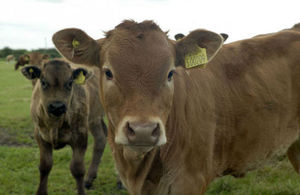Cuts to red tape to save farmers and taxpayers £70 million
Changes to livestock movement rules will save farmers and taxpayers £70 million over 10 years, Owen Paterson announced today.

Cuts to burdensome red tape will make it easier for farming businesses to flourish and improve our ability to prevent and control the spread of diseases such as bovine TB.
Speaking at the Oxford Farming Conference, Mr Paterson said:
Our farming industry is a cornerstone of our economy but for too long farmers have had to operate within overly complex rules and requirements.
This change to the system for reporting animal movements will save farmers and taxpayers millions of pounds, while increasing our resilience to animal diseases.
From 2016 we will be make the following changes:
- Cutting down on complex bureaucracy by allowing sheep farmers to increase the size of their farms from five miles to ten miles, meaning they can move their livestock around more without needing to report it
- Reducing red tape by removing the need to report grazing on temporary land within ten miles
- Making animals healthier and safer by ensuring animal movements are more traceable without increasing red tape, by scrapping Sole Occupancy Authorities (SOAs) and Cattle Tracing System (CTS) links. The changes announced today follow recommendations made by The Task Force on Farming Regulation. The task force was set up by Defra to find ways of cutting red tape and burdens on the farming industry to help it thrive.
Michael Seals, chair of the Animal health and Welfare Board for England, said:
These changes will improve our ability to react to disease outbreaks by creating a more effective system to report and track livestock movements. When an outbreak occurs, having a clear idea of where animals have been is vital in ensuing we can swiftly get to grips with the disease.
Richard MacDonald, chair of the Farming Regulation Taskforce, said:
These proposed changes follow closely part of the Task Force recommendations and will make a really significant improvement to local livestock movements.
Notes
- Read the recommendations of the Task Force on Farming Regulation
- Sole Occupancy Authorities (SOAs) currently allow livestock farmers to move cattle between sites they own without the usual standstill applying, which prevents the movement of any livestock to or from a premises for six days after any animals are moved onto the site. A SOA allows the farmer to group the sites he owns into a single holding for the purpose of standstill. Movements are still required to be recorded with local authorities.
- Cattle Tracing System (CTS) links currently allow livestock keepers who regularly move animals between two holdings to link the sites and avoid the need to report movements to the CTS links database.